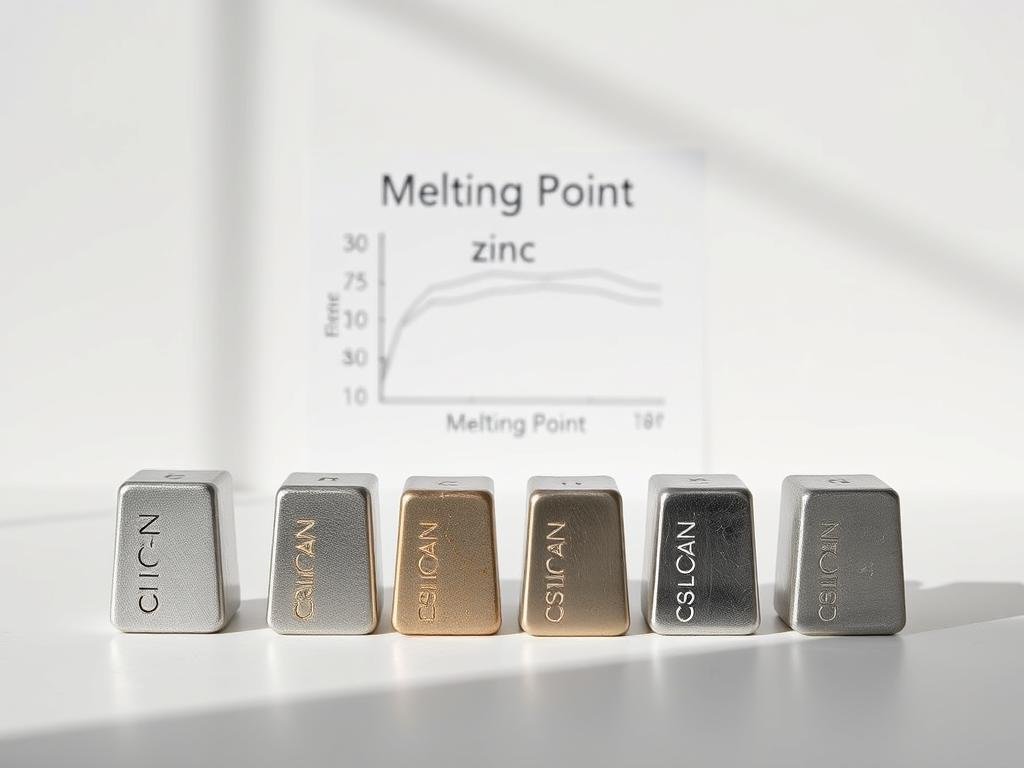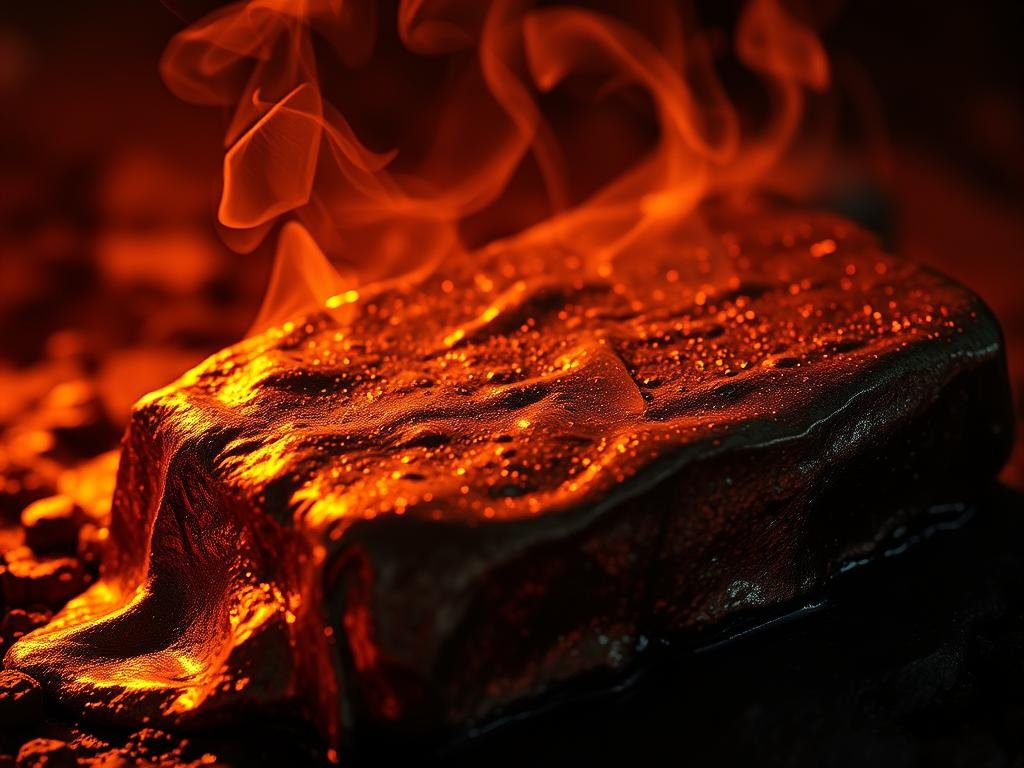Zinc is a bluish-white, lustrous metal with a relatively low melting temperature of 419.5°C (787.1°F), making it an ideal material for various machining processes.
The significance of zinc’s melting point lies in its suitability for die casting and coatings, where precise molding is required. Its low melting characteristics are advantageous in various industrial processes.
Zinc’s thermal properties compare favorably to other metals used in manufacturing, impacting energy efficiency and equipment requirements. This article will explore how zinc’s melting point influences its widespread use in industries, from automotive to household items.
Understanding Zinc as an Element
The element zinc, with its bluish-white appearance, is not only aesthetically notable but also industrially significant. As a chemical element with the symbol Zn and atomic number 30, zinc is the first element in group 12 (IIB) of the periodic table.
Chemical and Physical Properties of Zinc
Zinc is a slightly brittle metal at room temperature and has a shiny-greyish appearance when oxidation is removed. It becomes malleable when heated, making it valuable for various applications. The properties of zinc include its ability to form alloys, its corrosion resistance, and its role as an essential nutrient.
| Property | Description |
|---|---|
| Appearance | Bluish-white |
| Brittleness | Slightly brittle at room temperature |
| Malleability | Malleable when heated |
Historical Use and Discovery of Zinc
Zinc has been used for thousands of years, with zinc ores used to make the zinc-copper alloy brass long before zinc was recognized as a distinct element. The alchemist Paracelsus is credited with naming zinc after the German word “Zinke,” meaning prong or tooth. Andreas Sigismund Marggraf is credited with discovering pure metallic zinc in 1746.
“Zinc is an essential element for humans and plays a crucial role in various biological processes.”
Understanding zinc’s history and properties provides insight into its widespread use in modern industries, from die-casting to galvanizing steel.
The Zinc Melting Point: Facts and Figures
Understanding the melting point of zinc is essential for optimizing its use in manufacturing. The melting point is a fundamental property that determines the temperature at which zinc transitions from a solid to a liquid state.
Exact Melting Point of Pure Zinc
The melting point of pure zinc is approximately 419.5°C (787.1°F). This relatively low melting point compared to many other metals is due to zinc’s weaker metallic bonding and larger atomic size.
Factors Influencing Zinc’s Melting Point
The purity of zinc can slightly influence its melting point. Impurities in zinc can lower or raise the melting point depending on their nature and concentration.
| Purity Level | Melting Point (°C) | Melting Point (°F) |
|---|---|---|
| Pure Zinc | 419.5 | 787.1 |
| Zinc with Impurities | 418-420 | 784.4-788 |
The melting behavior of zinc is crucial for its industrial applications, particularly in casting and die-casting processes.
Thermal Properties of Zinc
Zinc’s ability to conduct and expand with heat is fundamental to its utility in manufacturing processes. Beyond its melting point, understanding zinc’s thermal properties is crucial for optimizing its performance in various applications.
Thermal Conductivity and Heat Transfer
Zinc has a thermal conductivity of 116 W/(m·K), which, although lower than metals like copper, is sufficient for its intended uses in heat exchangers and other components. This moderate level of thermal conductivity allows zinc to efficiently transfer heat, making it a suitable material for applications where heat management is critical.
Thermal Expansion Characteristics
Zinc’s coefficient of thermal expansion is approximately 30 × 10^-6/K. This property is vital in applications where temperature fluctuations could impact the dimensional stability of zinc components. Understanding this characteristic is essential for designing components that will maintain their integrity under varying thermal conditions.
| Property | Value | Unit |
|---|---|---|
| Thermal Conductivity | 116 | W/(m·K) |
| Coefficient of Thermal Expansion | 30 × 10^-6 | K^-1 |
The combination of zinc’s thermal conductivity and expansion characteristics influences its processing requirements and application suitability. By understanding these properties, manufacturers can better design and utilize zinc components in a variety of thermal environments.
Comparing Zinc Melting Point to Other Metals
When comparing the melting points of various metals, zinc stands out for its relatively low melting point. This characteristic makes zinc an attractive choice for certain manufacturing processes.
Common Metals and Their Melting Points
The melting points of metals vary significantly, influencing their applications and processing requirements. Here’s a comparison of zinc’s melting point with that of other common metals:
| Metal | Melting Point (°C) | Melting Point (°F) | Difference from Zinc (°C) | Difference from Zinc (°F) |
|---|---|---|---|---|
| Zinc | 419.5 | 787.1 | 0 | 0 |
| Aluminum | 660.3 | 1220.5 | 240.8 | 433.4 |
| Copper | 1084.62 | 1984.32 | 665.12 | 1197.22 |
| Iron | 1538 | 2800 | 1118.5 | 2012.9 |
Why Zinc Has a Relatively Low Melting Point
Zinc’s relatively low melting point can be attributed to its atomic structure and bonding characteristics. Specifically, zinc has a filled d subshell, which results in weaker interatomic forces compared to transition metals with unfilled d subshells. This leads to a lower energy requirement for zinc to change from a solid to a liquid state.

Advantages of Zinc’s Low Melting Point
The low melting point of zinc is crucial for enhancing efficiency in metal processing industries. This characteristic allows zinc to be used in various applications, from galvanization to die casting, with significant benefits.
Energy Efficiency in Processing
Zinc’s relatively low melting point means that less energy is required to melt it compared to metals with higher melting points. This energy efficiency translates into cost savings and a reduced carbon footprint in production facilities. For instance, the energy required to melt zinc is significantly lower than that needed for metals like steel or copper.
| Metal | Melting Point (°C) | Energy Required to Melt (kWh/kg) |
|---|---|---|
| Zinc | 419.5 | 0.129 |
| Aluminum | 660.4 | 0.398 |
| Copper | 1085 | 0.525 |
Equipment and Processing Requirements
The low melting point of zinc also simplifies equipment requirements. Furnaces and handling tools do not need to withstand extreme temperatures, reducing the cost of equipment and maintenance. This simplicity facilitates faster production cycles, as zinc can be melted quickly and solidifies rapidly after casting, increasing manufacturing efficiency.
Industrial Applications of Zinc Casting
The versatility of zinc casting has made it a preferred choice in modern manufacturing. Zinc die casting offers advantages such as low production costs, excellent dimensional stability, and the ability to produce intricate designs.
Die Casting Processes and Techniques
The die casting process involves forcing molten zinc into molds under high pressure to create complex, precise components with excellent surface finishes. This technique allows for the production of thin-walled parts with tight tolerances and good mechanical properties.
Industries Relying on Zinc Casting
Zinc casting is used in various industries, including automotive, electronics, and consumer products. In the automotive sector, zinc is used for components like door handles, brackets, and decorative trim. Electronics manufacturers use zinc for housings and structural components, while consumer product manufacturers utilize it for appliance parts and hardware.
The economic significance of zinc casting lies in its efficiency and cost-effectiveness, making it a cornerstone of modern manufacturing across diverse sectors.
Zinc Alloys and Their Melting Characteristics
Zinc alloys, such as brass and ZAMAK, are prized for their melting characteristics and diverse applications. These alloys are formed by combining zinc with other elements, resulting in materials with tailored properties for specific uses.
Common Zinc Alloys in Manufacturing
Several zinc alloys are commonly used in manufacturing, including ZAMAK (zinc-aluminum-magnesium-copper) series alloys and ZA (zinc-aluminum) alloys. Brass, an alloy of zinc and copper, is another significant example. These alloys are valued for their strength, ductility, and corrosion resistance.
- ZAMAK alloys are used in die casting for producing complex parts.
- ZA alloys offer excellent mechanical properties and are used in various industrial applications.
- Brass is widely used in musical instruments, plumbing fittings, and decorative items.
How Alloying Elements Affect Melting Properties
The addition of alloying elements to zinc significantly affects its melting properties. For instance, adding aluminum to zinc lowers its melting point and improves fluidity, making it easier to cast complex shapes. Copper, when alloyed with zinc to form brass, not only enhances strength and corrosion resistance but also modifies the melting characteristics.

Conclusion: The Significance of Zinc’s Melting Point in Modern Industry
With a melting point of 419.5°C, zinc offers a unique combination of properties that make it invaluable in various manufacturing processes. Its relatively low melting point facilitates efficient processing and cost-effective production, making it a crucial metal in numerous industries.
The applications of zinc are diverse, ranging from the protective galvanization of steel to precision die casting of complex components. As industries continue to innovate, zinc remains a vital material, offering both economic and technical advantages. Emerging trends in zinc alloys and casting technologies are expected to further expand its applications.
In conclusion, zinc’s melting point has profound implications for its industrial utility, and its continued relevance in modern manufacturing is assured.
